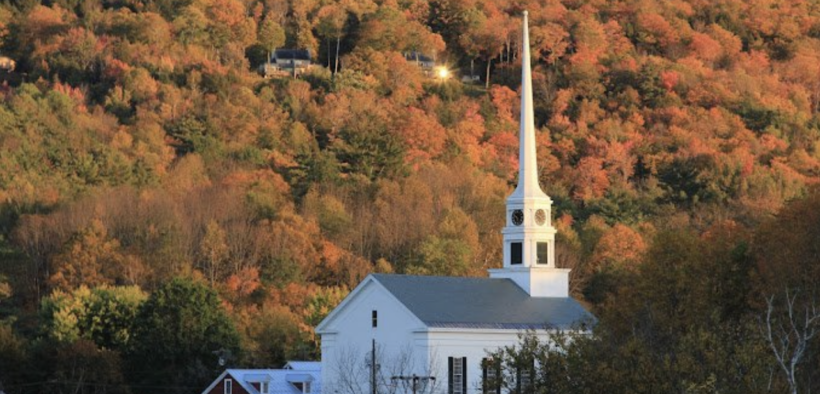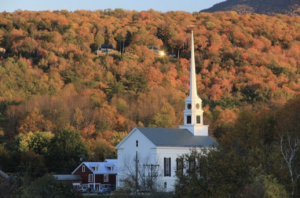Entering a ‘Postdenominational’ Era: Inside the Rise of the Unaffiliated Church

SPOKANE, Washington — Pastor Dan Haugh welcomed 21 new members to his congregation Sunday morning. Six months ago, he welcomed 19 others to Stowe Community Church.

While other houses of worship in Northern Vermont are shrinking, this nondenominational church has grown more than 80% since the start of the COVID-19 pandemic in 2020.
On the other end of the country in Spokane, Washington, Faith Bible Church — another nondenominational congregation — has seen an 18% uptick in worshippers since January, and during the pandemic had enough newcomers to plant two new churches.
“We’re definitely experiencing growth,” said Faith Bible Church Teaching Pastor Dan Jarms. “I think some of it is rebound, people coming back who were staying away, but we’ve had a lot of new growth.”
About 800 people fill the sanctuary there on Sunday mornings.
Between 2010 and 2020 nondenominational churches expanded by 2 million attendees and 9,000 congregations in the U.S., according to the 2020 U.S. Religion Census, which was released last week. The USRC is released every 10 years by the Association of Statisticians of American Religious Bodies.
Nondenominational churches now make up 4% of the U.S. population and constitute the third-largest religious group in the country after Catholics and the Southern Baptist Convention.
The Catholic Church has more than 61 million adherents, and the Southern Baptist Convention has the most congregations, with 51,000.
This boom in nondenominational churches is not surprising to Scott Thumma, director of the Hartford Institute for Religion Research, who started studying the religion in the late ‘90s.
“I saw that nondenominationalism was growing and none of my colleagues were paying much attention to them,” he said.
Thumma grew up in an independent Baptist church and said over the years he’s attended other independent congregations and studied megachurches.
“I knew they were similar but also different from the typical evangelical church,” he said. “I also was certain that they would continue to grow rapidly, and this congregational identity would become more popular over time due to the increasing individualism of American society.”
He explained that a nondenominational church is one that chooses not to affiliate with an official denomination. He said nondenominationalism is individualism at the congregational level.
Haugh said he agrees that autonomy is a draw.
“We get to discern what’s best for our local church, what works for us,” he explained. “We’re not locked into a curriculum or certain theological viewpoints or social issues.”
Stowe Community Church, which has 150 in attendance on Sundays, is diverse in political perspectives, the pastor said. And that’s OK, he added — it works when the congregation is an independent community.
“We’re more centered on what we have in common, what we share, than what might divide us,” he said, noting that what brings the church together is “God’s unconditional love and embrace of all people.”
He describes the church as “interdenominational,” which he said is a growing trend. Whether worshipers come from congregational or Nazarene roots, that’s embraced, he said.
“You don’t have to leave your tradition at the door,” Haugh said.
Though most nondenominational churches identify as evangelical, Thumma notes that there are theological differences among independent congregations. Some are more progressive than others, for instance.
Also, according to research from the 2020 Faith Community Today, or FACT, study, which included U.S. nondenominational and independent houses of worship, there are differences between nondenominational and evangelical denominational churches.
For example, nondenominational church buildings tend to be larger in terms of seating capacity.
Clergy are predominantly male, younger and less educated, with 30% having a Master of Divinity degree, compared to 47% of evangelical clergy.
Meanwhile, those in the pews at nondenominational churches are younger and tend to have more college degrees than those in an evangelical church.
Thumma said nondenominational churches are also more racially diverse.
“This multiracial reality is an intentional commitment for many of the nondenominational churches,” he explained, noting that when surveyed in the FACT study 48% of congregations “strongly agreed” they were striving to be diverse racially, ethnically and socially, compared to 21% of denominational evangelical churches.
After trying various churches, Savannah Tranchell recently started attending The Vine Church in Pasco, Washington, with her husband and 9-year-old son and said the congregation is more diverse than others they visited.
Her husband grew up in the Church of Jesus Christ of Latter-day Saints, and she described her childhood religion as “Baptist adjacent.”
They’d been looking for a Christian church but struggled to find one that fit them.
“We tried Nazarene, ELCA, a gender-affirming church, and what we found is that denominational ones are almost archaic with hymnals, no electronics,” she said.
The Vine is a mix of modern and acoustic worship.
Most nondenominational churches describe their worship as “innovative” with the majority having informal services with projector screens and contemporary music.
Besides the music, Tranchell said the nondenominational church is appealing because the community has “local control of what matters to you, not matters to your home office.”
She added that many mainline religions seem to be steeped in values that don’t necessarily reflect the community.
At first Tranchell found a larger evangelical church that her family attended for a while, but it felt too big and too conservative.
Tranchell said The Vine, which has about 100 attendees, is egalitarian. The church is led by a husband-and-wife team who share in leadership equally.
In the few months she’s been there, she said she’s seen other new families join as well.
Thumma said in his research he also found many denominational churches beginning to pull away from their affiliations.
“This rise in those congregations overtly asserting independence is only the tip of the iceberg. I contend that a large number of denominationally affiliated churches have also become functionally nondenominational,” he said.
According to a 2015 FACT survey, 2.3% of churches reported they had become independent in the previous 10 years, and another 0.5% had “seriously considered it.”
“That is over 8,000 becoming nondenominational and almost 2,000 more considering the switch,” Thumma explained.
He said this is largely because decisions about resources, literature, educational materials, worship music, mission, what to support and other issues are increasingly being made at the local level rather than through denominational headquarters.
“The authority for the life of the denominational church is becoming lodged within the church itself with less regard for the authority of the larger body, the external entity,” he said. “More churches are operating as if they were isolated entities with less regard for conference ministers, bishops or denominational pronouncements, rules, literature and materials, etc.”
He calls this the post-denominational era and says the ground is eroding for denominational identities.
The census data might confirm his speculations, as many traditions are declining in membership, like the United Methodist Church and the Southern Baptists, both of which fell by about 2 million adherents from 2010 to 2020.
This article was originally published by Religion UnPlugged.
Main photo: Stowe Community Church in Stowe, Vermont. Creative Commons photo.



